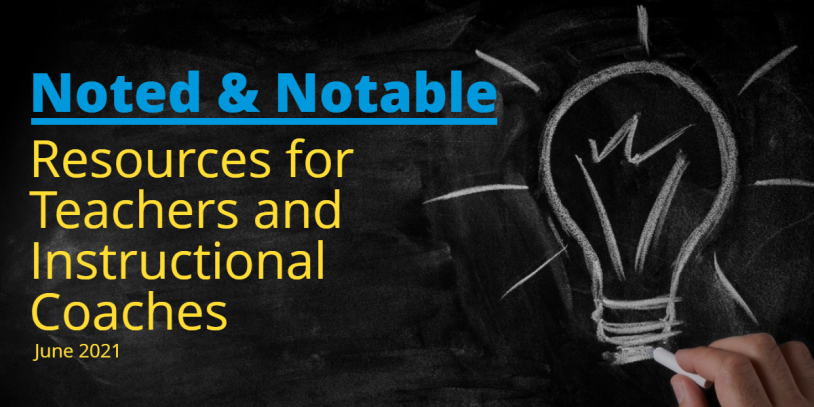Resources for Teachers and Instructional Coaches – June 2021

It’s June, which means the end of the school year for most teachers! This month, we’ve been reading about how students and teachers can truly take a break this summer and education trends to be in-the-know about for the fall. Check out these top June reads and resources with highlights and article links below.
Teachers, here’s how to stick to the ‘break’ in summer break
Educators are known for their hard work and relentless spirit. But summer can be an important time to lay low and recharge. Here are 4 ways to truly take a break once school is done:
1. Read what brings you joy instead of educational research books: If you typically take home PD books to prepare for the next school year, swap these out for books you’ve always wanted to read.
2. Seek out a new avenue for seasonal work instead of teaching summer camp or school: This might be the summer you focus on your side hustle. By trying out a new employment adventure, you can meet new people, expand your skill base, and supplement your income.
3. Develop a hobby instead of focusing on PD: My summer calendar would be filled with education conferences near and far … While I gained so much as an educator networking and learning at these conferences, I am taking a pause this summer. You might want to try learning how to knit, paint, cook, woodwork, or skateboard.
4. Look forward to your break instead of reflecting back on your school year: Imagine yourself in August as the summer is winding down. Do you imagine feeling refreshed? Renewed? How will you fill in the blank in this sentence? “I am so glad I did _____ for myself this summer.”
Read more on Edutopia: 4 Ways to Take a Real Break This Summer
Putting mental health at the top of kids’ summer bucket lists
As teachers assign summer reading, they should also be encouraging students to focus on their mental health for the next few months of break from school. How can they do this? Hint: it *doesn’t* involve screens.
Come September, what will young people look back on this summer and remember? Will their highlight reel be an endless stretch of mornings, afternoons, and evenings in their bedroom, faces down, staring into their phones? For too many students, this has been a necessary reality for more than a year.
My fondest hope for young people this summer is that they spend as many hours as possible screen-free, talking to people in three dimensions rather than two. The blue canopy sky above has much more to commend it than the blue-light glow of a phone.
Recent research shows a remarkably strong link between green space and mental health. Young people who grow up near more greenery—literally more vegetation in their immediate neighborhood—are less likely to suffer from depression, anxiety, and a range of other mental-health afflictions. This is true whether children are growing up in cities (think parks and street trees) or in rural communities. And the dose-response relationship between greenery and mental health holds even when controlling for socioeconomic status and other risk factors.
Read more on EdWeek: How to Help Students Take a Mental-Health Break This Summer
Already wondering which ed tech trends to look for next year?
During the pandemic, education technology became front and center in the classroom. Now teachers and leaders are considering which trends will be coming along for the ride into the next school year. Take a look at three trends to be watching for:
1) Micro Lessons
Teaching in mini lesson format with intermittent formative assessment helps the teacher determine where the learner is with every incremental lesson. Just like micro credentialing but at a much faster pace.
2) Integrated Whole Classroom
Thinking about classroom design as having all the necessary technologies — interactive panels, individual devices for students and teachers, integrated software, integrated hardware solutions, accessible high quality digital content, interactive applications — along with a teacher who is well equipped to design classes that incorporate effective instructional strategies will yield high performing students, no matter who you are teaching!
3) Rethinking Assessment
Formative and benchmark assessments provide a much clearer perspective of where the learner is with their learning on an ongoing basis. Considering portfolio assessment is another alternative to high-stakes assessments and it enables the students’ voice to be present in their own knowledge assessment.
Read more on Tech & Learning: 3 Education Trends to Watch for the Upcoming School Year
Missed our May Notable Content? Find it here!

